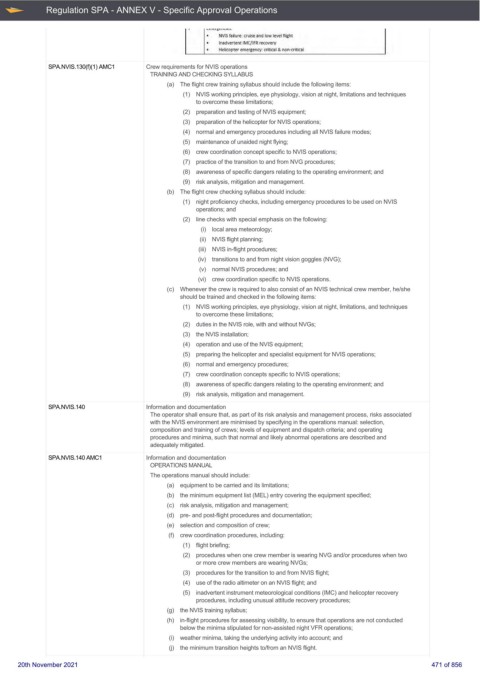Page 471 - UK Air Operations Regulations (Consolidated) 201121
P. 471
~
~ Regulation SPA - ANNEX V - Specific Approval Operations Centrik
NVIS fa ilure: cruise and low level flight
lnadvenent IMC/IFR recovery
Helicopter emergency: critica l & nort-crfl:ical
SPA.NVIS.130(f)(1) AMC1 Crew requirements for NVIS operations
TRAINING AND CHECKING SYLLABUS
(a) The flight crew training syllabus should include the following items:
(1) NVIS working principles, eye physiology, vision at night, limitations and techniques
to overcome these limitations;
(2) preparation and testing of NVIS equipment;
(3) preparation of the helicopter for NVIS operations;
(4) normal and emergency procedures including all NVIS failure modes;
(5) maintenance of unaided night flying;
(6) crew coordination concept specific to NVIS operations;
(7) practice of the transition to and from NVG procedures;
(8) awareness of specific dangers relating to the operating environment; and
(9) risk analysis, mitigation and management.
(b) The flight crew checking syllabus should include:
(1) night proficiency checks, including emergency procedures to be used on NVIS
operations; and
(2) line checks with special emphasis on the following:
(i) local area meteorology;
(ii) NVIS flight planning;
(iii) NVIS in-flight procedures;
(iv) transitions to and from night vision goggles (NVG);
(v) normal NVIS procedures; and
(vi) crew coordination specific to NVIS operations.
(c) Whenever the crew is required to also consist of an NVIS technical crew member, he/she
should be trained and checked in the following items:
(1) NVIS working principles, eye physiology, vision at night, limitations, and techniques
to overcome these limitations;
(2) duties in the NVIS role, with and without NVGs;
(3) the NVIS installation;
(4) operation and use of the NVIS equipment;
(5) preparing the helicopter and specialist equipment for NVIS operations;
(6) normal and emergency procedures;
(7) crew coordination concepts specific to NVIS operations;
(8) awareness of specific dangers relating to the operating environment; and
(9) risk analysis, mitigation and management.
SPA.NVIS.140 Information and documentation
The operator shall ensure that, as part of its risk analysis and management process, risks associated
with the NVIS environment are minimised by specifying in the operations manual: selection,
composition and training of crews; levels of equipment and dispatch criteria; and operating
procedures and minima, such that normal and likely abnormal operations are described and
adequately mitigated.
SPA.NVIS.140 AMC1 Information and documentation
OPERATIONS MANUAL
The operations manual should include:
(a) equipment to be carried and its limitations;
(b) the minimum equipment list (MEL) entry covering the equipment specified;
(c) risk analysis, mitigation and management;
(d) pre- and post-flight procedures and documentation;
(e) selection and composition of crew;
(f) crew coordination procedures, including:
(1) flight briefing;
(2) procedures when one crew member is wearing NVG and/or procedures when two
or more crew members are wearing NVGs;
(3) procedures for the transition to and from NVIS flight;
(4) use of the radio altimeter on an NVIS flight; and
(5) inadvertent instrument meteorological conditions (IMC) and helicopter recovery
procedures, including unusual attitude recovery procedures;
(g) the NVIS training syllabus;
(h) in-flight procedures for assessing visibility, to ensure that operations are not conducted
below the minima stipulated for non-assisted night VFR operations;
(i) weather minima, taking the underlying activity into account; and
(j) the minimum transition heights to/from an NVIS flight.
20th November 2021 471 of 856

